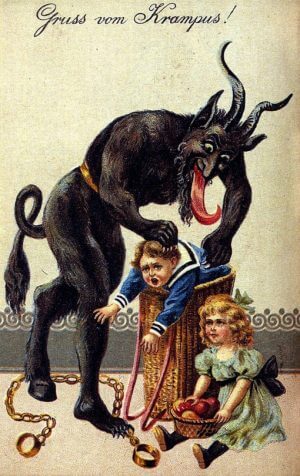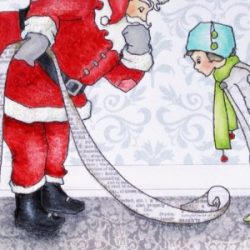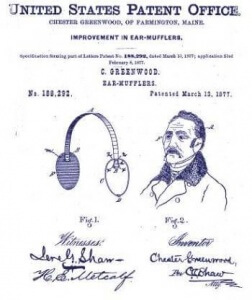December 5 is Krampus
 On Santa’s List Day, we suggested that children who learn the list of who’s naughty and nice has been finalized might be tempted to misbehave in the remaining days before Christmas, with no fear of reprisal. Krampus, today’s holiday, should thoroughly dispel that idea.
On Santa’s List Day, we suggested that children who learn the list of who’s naughty and nice has been finalized might be tempted to misbehave in the remaining days before Christmas, with no fear of reprisal. Krampus, today’s holiday, should thoroughly dispel that idea.
Krampus may have originated as a pagan figure in Europe’s Alpine regions, becoming associated with St. Nicholas in the 17th century. The word Krampus is derived from the Old High German word for “claw”(Krampen). He is a goat-headed devil with fangs, a pointed tongue and two cloven hooves or one hoof and one human foot.
Unlike the Santa Claus of North American tradition, St. Nicholas only pays attention to the good children. He brings Krampus along on his rounds to deal with little miscreants for whom receiving a lump of coal is the least of their worries. He carries chains, birch branches or a whip to mete out punishment and sometimes a sack or basket to capture bad children so he can drown them, eat them or deliver them to Hell.
Europeans have been exchanging greeting cards featuring Krampus for two centuries. Greetings from the Krampus (Gruß vom Krampus) cards feature humorous verse and depict the devil looming over children or pursuing buxom women. Modern cards tend to have a cuter, less menacing version of Krampus.
Although its tastefulness and propriety have been questioned during the past century, the holiday’s popularity has grown; celebrations have cropped up all over North America, including Toronto, Dallas, Philadelphia and Washington, DC. We assume that the successful completion of chores has skyrocketed in those towns.
Happy Krampus!
![]()

 Today is Santa’s List Day. According to legend, it’s the day when Kris Kringle finalizes his list, double checks it for accuracy and puts the elves to work manufacturing gifts for children who’ve toed the line of acceptable behavior within their age groups.
Today is Santa’s List Day. According to legend, it’s the day when Kris Kringle finalizes his list, double checks it for accuracy and puts the elves to work manufacturing gifts for children who’ve toed the line of acceptable behavior within their age groups. Chester Greenwood Day
Chester Greenwood Day
 Today is Eat a Red Apple Day. Unlike the freewheeling, any-apple-goes
Today is Eat a Red Apple Day. Unlike the freewheeling, any-apple-goes